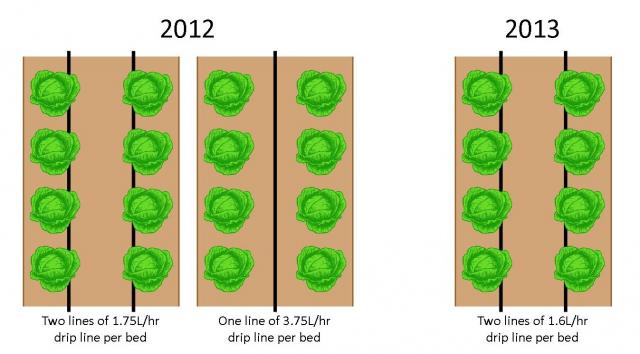Demonstration information
Equipment specifications
Both demonstration crops were grown on 1.7m wide beds with two rows of cauliflower per bed, giving 80cm between row spacing and 35cm within row spacing. Pressure compensated drip line with 30cm dripper spacing was used for both crops.
In 2012, two different drip line configurations were used, each with different emitter rates:
- Two lines of 1.75L/hr drip line per bed. Drip lines were aligned along each row of plants.
- A single line of 3.75L/hr drip line per bed. Drip line was aligned to centre of beds.
In 2013, one drip line and configuration were used:
- Two lines of 1.6L/hr drip line per bed. Drip lines were aligned along each row of plants.
Figure 1 is a schematic diagram of the drip line configurations used in both years.
The choice of drip line was based on soil type and infiltration rates. Optimum specification will vary depending on soil type, water-holding capacity, water infiltration rate, system set-up and intended use.
The variety Boris was used in both years.
Irrigation scheduling and fertilisers
Irrigation rates for all treatments were based on a percentage replacement of daily evaporation. For example, if a plot was being watered at 50% evaporation replacement and the evaporation for the previous day was 7.6mm then 3.8mm of irrigation would be applied.
In 2012, all plots received 100% evaporation replacement. In 2013, the overhead irrigated plot received 100% evaporation replacement and the four drip-irrigated plots received either 100%, 80%, 60% or a variable evaporation replacement rate.
The variable irrigated plot received the following rates based on crop growth stage and soil moisture readings:
- 0-2 weeks after transplanting – 80% evaporation replacement
- 2-5 weeks after transplanting – 50% evaporation replacement
- 5-7 weeks after transplanting – 80% evaporation replacement
- 7-9 weeks after transplanting – 100% evaporation replacement
- 9 weeks after transplanting to harvest – 120% evaporation replacement.
Overhead and drip-irrigated plots received the same fertiliser regime in both demonstrations. Liquid post-plant fertiliser was applied through a boomspray for overhead-irrigated plots while drip line plots received fertiliser through the drip line.
Soil moisture monitoring
Soil moisture sensors were placed under all plots with sensors located at 0-15cm, 15-30cm and 30-60cm below the soil surface.
In 2012, data indicated that soil moisture in the root zone was more constant when using drip irrigation. With overhead irrigation, soil moisture would peak with irrigation events then fall as water drained away.
The variation in soil moisture was much smaller under the two lines per bed drip plot and smaller again under the one line per bed drip plot. More consistent soil moisture could lead to more even growth of a crop as a stable growing environment is maintained.
In 2013, soil moisture sensors under the drip irrigated plots receiving 60%, 80% and 100% evaporation replacement all showed steady moisture levels followed by a decline in soil moisture below crop requirements at different crop stages. The points at which soil moisture started to decline indicated that water requirements of the crop had increased and were no longer being met.
Soil moisture in the 60% evaporation replacement plot began to decline four weeks after transplanting. Soil moisture in the 80% evaporation replacement plot began to decline six weeks after transplanting. In the 100% evaporation replacement plot, soil moisture did not start to decline until nine weeks after transplanting, just 10 days prior to the first harvest.
In 2012, the drip irrigated plot received 100% evaporation replacement for the life of the crop. This plot did not show any signs of soil moisture levels declining below the required level for healthy crop growth.
The soil moisture data gathered during these demonstrations allows estimates of water requirements at different crop growth stages. Crops generally require different amounts of water at different growth stages. Soil moisture data from the demonstration crops suggests that irrigation applied early in crop life may be reduced to 50% evaporation replacement. The water application rate would increase as the crop grows.
Irrigation application rate changes can be made with any irrigation system, so it is not necessary to install a drip irrigation system to reduce water use based on matching crop water requirements with crop age and evaporation.

